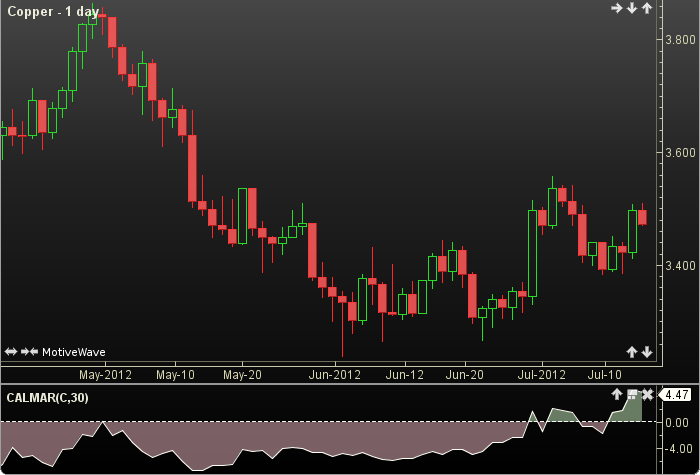Calmar Ratio
The Calmar Ratio was authored by Terry W. Young in 1991. The higher the Calmar Ratio the better the instrument’s performance. The Calmar Ratio is the annual return divided by the maximum peak to trough negative return. The user must select linear bars but may change the input (close) and period length. This indicator’s definition is further expressed in the condensed code given in the calculation below.

How To Trade Using the Calmar Ratio
The Calmar Ratio may be used to evaluate an instrument’s performance. No trading signals are calculated.
How To Access in MotiveWave
Go to the top menu, choose Study>Performance>Calmar Ratio
or go to the top menu, choose Add Study, start typing in this study name until you see it appear in the list, click on the study name, click OK.
Important Disclaimer: The information provided on this page is strictly for informational purposes and is not to be construed as advice or solicitation to buy or sell any security. Please see our Risk Disclosure and Performance Disclaimer Statement.
Calculation
//input = price, user defined, default is close
//period = p1, user defined, default is 30
//abs = absolute value, pow = power
//index = current bar number
BarSize bar = getBarSize(); if (bar.getType() == BarSizeType.LINEAR) barMin = bar.getInterval(); else return; minPerYr = 60*24*30*12; barsPerYr = minPerYr/barMin; priorP = price[index-p1]; maxDn = highest(index, p1, input); dd = (price - maxDn) / maxDn; ret = (price/priorP) - 1; //returns for the period power = barsPerYr/p1; anualRet = Math.pow((1 + ret), power) - 1; //convert to annual return maxDd = lowest(index, p1, DD); //largest negative value Plot: calmar = anualRet / Math.abs(maxDd);
